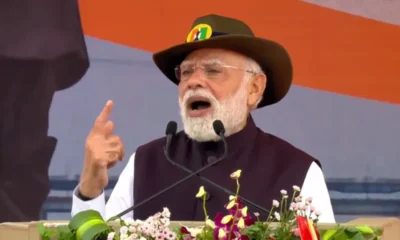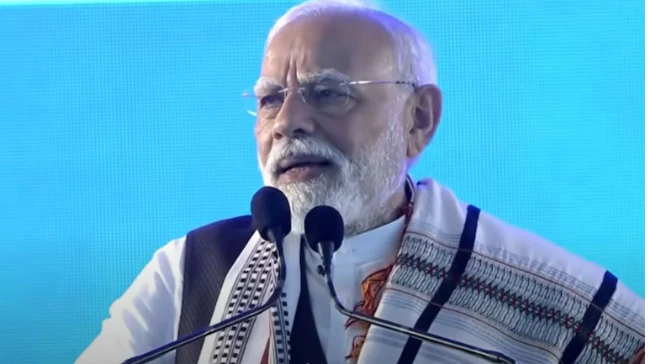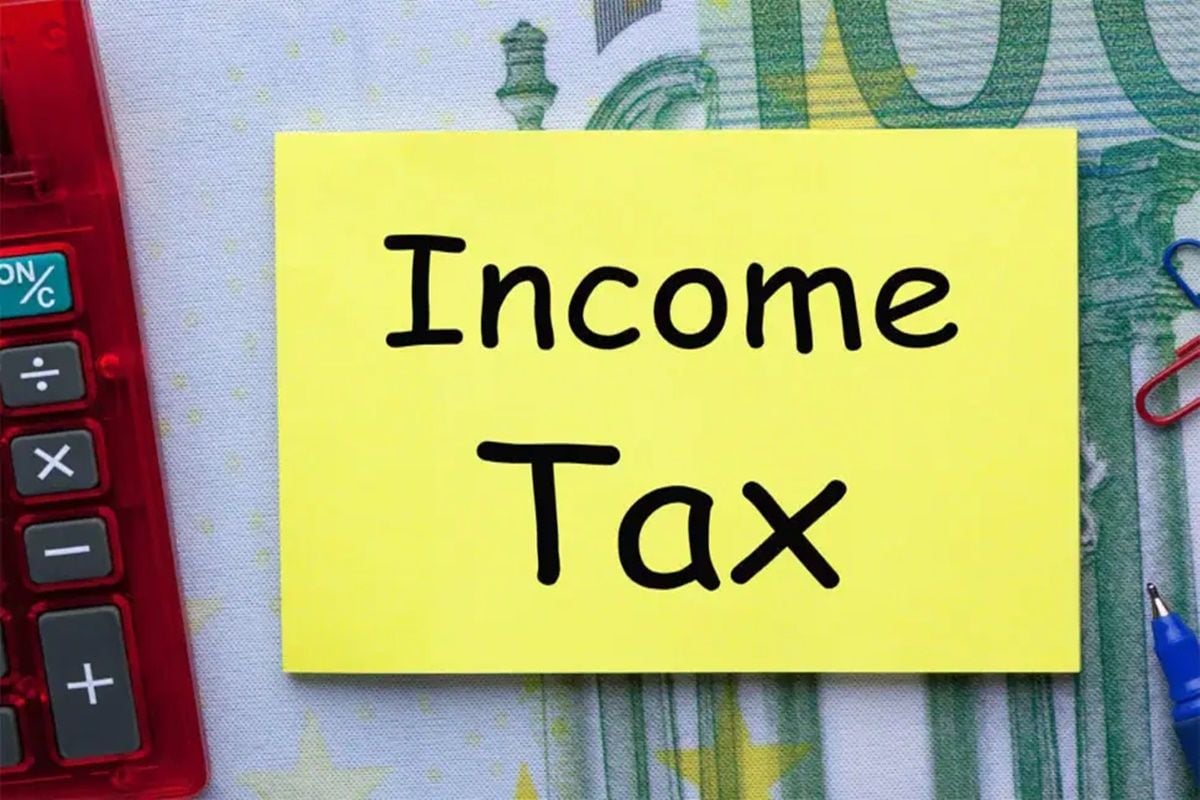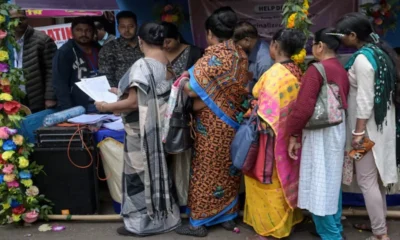[vc_row][vc_column][vc_column_text]India’s first full-time woman Finance Minister Nirmala Sitharaman – Indira Gandhi held the portfolio as Prime Minister – presented the first budget of Narendra Modi government’s second term, for the financial year 2019-2020 in the Parliament today (Friday, July 5).
Sitharaman began her over 2-hour long speech thanking voters for bringing back the Modi government: “The recent election was charged with brimming home and desire for a bright and stable ‘New India’. Voter turnout was highest; every section came to stamp their approval for performing Government,” she said.
She started by laying out the path to make India a 5 trillion dollar economy in the coming five years and said Indian economy will become a 3 trillion dollar economy this year and is World’s 3rd largest economy in terms of Purchasing Power Parity.
Some of the key highlights of the budget, said a government release, include:
- government’s intention to invest Rs. 100 lakh crore in infrastructure in next 5 years,
- enhanced target of over one lakh 5,000 crore of disinvestment in 2019-20,
- proposal to provide Rs.70,000 crore to PSBs to boost credit,
- doubling of food security budget in last 5 years,
- faster adoption of Electric vehicles with an outlay of Rs.10,000 crore,
- opening of 18 new Indian diplomatic missions in Africa,
- development of 17 iconic Tourism Sites into world class tourist destinations and
- issuance of new series of coins of 1,2,5,10 & 20 rupees
In what she called “New Deals for the Rural and Agricultural sectors of the Economy” the Finance Minister listed a number of schemes:
- Har Ghar Jal to all rural households by 2024 under Jal Jeevan Mission,
- “Housing for All” by 2022 under Pradhan Mantri Awas Yojana-(Gramin),
- upgradation of 1,25,000 kms of rural road under PMGSY-III in 5 years with an outlay of more than 80,000 crore with all weather connectivity provided to over 97% of such habitations,
- common facility centres under SFURTI for Bamboo, Honey and Khadi clusters,
- setting up of 80 Livelihood Business Incubators and 20 Technology Business incubators in 2019-20 to develop 75,000 skilled entrepreneurs in agro-rural industry sectors
The Finance Minister said that mega programmes and services initiated and delivered during the last 5 years will now be further accelerated and sincere efforts will be made to further simplify procedures, incentivize performance, reduce red-tape and make the best use of technology to achieve the desired goals.
The Finance Minister elaborated that the Indian economy will grow to become a 3 trillion dollar economy in the current year and will reach the vision of Prime Minister to become 5 trillion dollar economy in the next five years. It is now the sixth largest in the world, while it was at 11th position in 2014. In Purchasing Power Parity terms, India is in fact, the 3rd largest economy already, only next to China and the USA.
She said that to attain this and more the country needs to continue undertaking many structural reforms like the many big reforms in particular in the last 5 years in indirect taxation, bankruptcy and real estate. Even the common man’s life was being changed through MUDRA loans to help him do his business, and through several programmes it was being ensured that his/her kitchen had become smokeless, his/her house got electricity connection and women’s dignity was respected with the provision of toilets in homes.
Sitharaman said that gone are the days of policy paralysis and license-quota-control regimes. India Inc. are India’s job-creators and they are the nation’s wealth-creators. She said, “Together, with mutual trust, we can gain, catalyse fast and attain sustained national growth. I wish to propose a number of initiatives as part of a framework for kick-starting the virtuous cycle of domestic and foreign investments”.
The Finance Minister flagged the ten points of Government’s Vision:
- Building physical and social infrastructure;
- Digital India reaching every sector of the economy;
- Pollution free India with green Mother Earth and Blue Skies;
- Make in India with particular emphasis on MSMEs, Start-ups, defence manufacturing, automobiles, electronics, fabs and batteries, and medical devices;
- Water, water management, clean Rivers;
- Blue Economy;
- Space programmes. Gaganyan, Chandrayan and Satellite programmes;
- Self-sufficiency and export of food-grains, pulses, oilseeds, fruits and vegetables;
- Healthy society –Ayushman Bharat, well-nourished women & children. Safety of citizens;
- Team India with Jan Bhagidari. Minimum Government Maximum Governance.
Connectivity – roads, waterways, aviation, railways
Referring to connectivity as the lifeblood of an economy, the Finance Minister said that the Government has given a massive push to all forms of physical connectivity through Pradhan Mantri Gram Sadak Yojana, industrial corridors, dedicated freight corridors, Bhartamala and Sagarmala projects, Jal Marg Vikas and UDAN Schemes.
While the industrial corridors would improve infrastructure availability for greater industrial investment in the catchment regions, the dedicated freight corridors would mitigate the congestion of our railway network benefitting the common man. The ambitious programme of Bharatmala would help develop national road corridors and highways, while Sagarmala would enhance port connectivity, modernization and port-linked industrialization.
If Sagarmala is aimed at improving the infrastructure for external trade, equally it is the poor man’s transport too. Waterways are proven as a cheap mode of transport. The Jal Marg Vikas project for capacity augmentation of navigation on National Waterways is aimed at smoothening internal trade carried through inland water transport. These initiatives will improve logistics tremendously, reducing the cost of transportation and increasing the competitiveness of domestically produced goods.
The Finance Minister said that as the world’s third largest domestic aviation market, the time is ripe for India to enter into aircraft financing and leasing activities from Indian shores. She said, for providing an enabling ecosystem for growth in India of Maintenance, Repair and Overhaul (MRO) industry, it is proposed to leverage India’s engineering advantage and potential to achieve self-reliance in this vital aviation segment. She added that the government will adopt suitable policy interventions to create a congenial atmosphere for the development of MRO in the country.
The Finance Minister informed that Phase-II of FAME Scheme 2019, following approval of the Cabinet with an outlay of Rs.10,000 crore for a period of 3 years, has commenced from 1st April, 2019. The main objective of the Scheme is to encourage faster adoption of Electric vehicles by way of offering upfront incentive on purchase of Electric vehicles and also by establishing the necessary charging infrastructure for electric vehicles.
On the Railways, Sithraman said that it is estimated that Railway Infrastructure would need an investment of Rs. 50 lakh crores between 2018-2030. Given that the capital expenditure outlays of Railways are around 1.5 to 1.6 lakh crores per annum, completing even all sanctioned projects would take decades. It is therefore proposed to use Public-Private Partnership to unleash faster development and completion of tracks, rolling stock manufacturer and delivery of passenger freight services.
She said that to take connectivity infrastructure to the next level, government will build on the successful model in ensuring power connectivity – One Nation, One Grid – that has ensured power availability to states at affordable rates and she proposed to make available a blueprint this year for developing gas grids, water grids, i-ways, and regional airports.
Pension scheme
Referring to welfare measures, the Finance Minister said that the Government of India has decided to extend the pension benefit to about three crore retail traders & small shopkeepers whose annual turnover is less than Rs.1.5 crore under a new Scheme namely Pradhan Mantri Laghu Vyapari Mann-Dhan Yojana (PMLVMY). Enrolment into the Scheme will be kept simple requiring only Aadhaar and a bank account and rest will be on self-declaration.
For capital investment
Recognizing that investment-driven growth requires access to low cost capital, the Finance Minister said India requires investments averaging Rs. 20 lakh crores every year (USD 300 billion a year) and therefore a number of measures are proposed to enhance the sources of capital for infrastructure financing:
- A Credit Guarantee Enhancement Corporation for which regulations have been notified by the RBI, will be set up in 2019-20.
- An action plan to deepen the market for long term bonds including for deepening markets for corporate bond repos, credit default swaps etc., with specific focus on infrastructure sector, will be put in place.
- It is proposed to permit investments made by FIIs/FPIs in debt securities issued by IDF-NBFCs to be transferred/sold to any domestic investor within the specified lock-in period.
On the subject of Foreign Direct Investment, the FM said that FDI inflows into India have remained robust despite global headwinds. India’s FDI inflows in 2018-19 remained strong at US$ 64.375 billion marking a 6% growth over the previous year. She added that the Government will examine suggestions of further opening up of FDI in aviation, media (animation, AVGC) and insurance sectors in consultation with all stakeholders and suggested following measures:
a.100% Foreign Direct Investment (FDI) will be permitted for insurance intermediaries.
- Local sourcing norms will be eased for FDI in Single Brand Retail sector.
- FPIs will be permitted to subscribe to listed debt securities issued by ReITs and InvITs.
On a similar issue, the Finance Minister informed that even though India is the world’s top remittance recipient, NRI investment in Indian capital markets is comparatively less. With a view to provide NRIs with seamless access to Indian equities, she proposed to merge the NRI-Portfolio Investment Scheme Route with the Foreign Portfolio Investment Route.
Rural India
Dwelling on the rural issues and Rural India, the Finance Minister said that Prime Minister Narendra Modi’s two mega initiatives of Ujjwala Yojana and Saubhagya Yojana-have transformed the lives of every rural family, dramatically improving ease of their living. Household access to clean cooking gas has seen an unprecedented expansion, through provision of more than 7 crore LPG connections. All villages, and almost 100% households across the country have been provided with electricity.
She informed that by 2022, the 75th year of India’s independence, every single rural family, except those who are unwilling to take the connection will have an electricity and a clean cooking facility. Similarly, under Pradhan Mantri Awas Yojana – Gramin (PMAY-G) a total of 1.54 crore rural homes have been completed in the last five years. In the second phase of PMAY-G, during 2019-20 to 2021-22, 1.95 crore houses are proposed to be provided to the eligible beneficiaries. These houses are also being provided with amenities like toilets, electricity and LPG connections.
With the use of technology, the DBT platform and technology inputs, average number of days for completion of houses has reduced from 314 days in 2015-16 to 114 days in 2017-18, she said.
The Finance Minister said that Pradhan Mantri Gram Sadak Yojana (PMGSY) has brought many socio economic gains in the rural areasand its target for completion was advanced from 2022 to 2019, as all weather connectivity has now been provided to over 97% of such habitations. This has been possible by maintaining a high pace of road construction of 130 to 135 km per day in the last 1,000 days. She underlined that the PMGSY-III is envisaged to upgrade 1,25,000 kms of road length over the next five years, with an estimated cost of Rs. 80,250 crore.
Rural economy
Sitharaman said that the “Scheme of Fund for Upgradation and Regeneration of Traditional Industries” (SFURTI) aims to set up more Common Facility Centres (CFCs) to facilitate cluster based development to make the traditional industries more productive, profitable and capable for generating sustained employment opportunities. The focused sectors are Bamboo, Honey and Khadi clusters. The SFURTI envisions setting up 100 new clusters during 2019-20 which should enable 50,000 artisans to join the economic value chain.
Further, to improve the technology of such industries, the Scheme for Promotion of Innovation, Rural Industry and Entrepreneurship (ASPIRE) has been consolidated for setting up of Livelihood Business Incubators (LBIs) and Technology Business Incubators (TBIs).
The Scheme contemplates to set up 80 Livelihood Business Incubators (LBIs) and 20 Technology Business Incubators (TBIs) in 2019-20 to develop 75,000 skilled entrepreneurs in agro-rural industry sectors.
Government also hopes to form10,000 new Farmer Producer Organizations, to ensure economies of scale for farmers. To provide benefits to fishermen communities through a focused Scheme –the Pradhan Mantri Matsya Sampada Yojana (PMMSY) – the Department of Fisheries will establish a robust fisheries management framework. They will address critical gaps in strengthening the value chain, including infrastructure, modernization, traceability, production, productivity, post-harvest management, and quality control.Finance Minister said that ensuring India‟s water security and providing access to safe and adequate drinking water to all Indians is a priority of the Government.
A major step in this direction has been the constitution of the Jal Shakti Mantralaya, integrating the Ministry of Water Resources, River Development and Ganga Rejuvenation and Ministry of Drinking Water and Sanitation. This new Mantralaya will look at the management of our water resources and water supply in an integrated and holistic manner and will work with States to ensure Har GharJal हरघरजल– (piped water supply) to all rural households by 2024 under the Jal Jeevan Mission. The Government has identified 1592 Blocks which are critical and over exploited, spread across 256 District for the Jal Shakti Abhiyan. Besides using funds available under various Schemes, the Government will also explore possibility of using additional funds available under the Compensatory Afforestation Fund Management and Planning Authority (CAMPA) for this purpose.
Under the Pradhan Mantri Gramin Digital Saksharta Abhiyan, over two crore rural Indians have so far been made digitally literate. To bridge rural-urban digital divide, Bharat-Net is targeting internet connectivity in local bodies in every Panchayat in the country. This will be speeded up with assistance from Universal Obligation Fund and under a Public Private Partnership arrangement.
Under Pradhan Mantri Awas Yojana – Urban (PMAY-Urban), over 81 lakh houses with an investment of about Rs.4.83 lakh crores have been sanctioned of which construction has started in about 47 lakh houses. Over 26 lakh houses have been completed of which nearly 24 lakh houses have been delivered to the beneficiaries. There is large scale adoption of new technologies for construction of these houses. Over 13 lakh houses have so far been constructed using these new technologies.
The 150th birth anniversary of Mahatma Gandhi is an apt occasion for us to re-dedicate ourselves to the ideals of Mahatma Gandhi. Prime Minister Modi took the Sankalp of achieving Gandhiji’s resolve of Swachh Bharat to make India Open Defecation Free by 2nd October 2019. “I am very satisfied and happy to report that this would be achieved by the 2nd October,” she said.
Education
The Finance Minister said that the Government will bring in a New National Education Policy to transform India’s higher education system to one of the global best education systems. The new Policy proposes major changes in both school and higher education among others, better Governance systems and brings greater focus on research and innovation. It also proposed to establish a National Research Foundation (NRF) to fund, coordinate and promote research in the country.
She said that these initiatives have up-graded the quality of education. “There was not a single Indian institution in the top 200 in the world university rankings five years back. Due to concerted efforts by our institutions to boost their standards and also project their credentials better, we have three institutions now –two IITs and IISc Bangalore –in the top 200 bracket,” said the FM.
Sitharaman said that through the implementation of Kayakave Kailasa‟, the Government will enable about 10 million youth to take up industry-relevant skill training through the Pradhan Mantri Kaushal Vikas Yojana (PMKVY). This is helping to create a large pool of skilled manpower with speed and high standards.
She also added that the government will also lay focus on new-age skills like Artificial Intelligence (AI), Internet of Things, Big Data, 3D Printing,Virtual Reality and Robotics, which are valued highly both within and outside the country, and offer much higher remuneration.
Working class
She said that the Government has decided to increase contribution to 12% for both Employees Provident Fund and Employee’s Pension Scheme for all sectors w.e.f. 01.04.2018. As a result of this measure, number of beneficiaries increased by almost 88 lakhs during FY 2018-19. As on 31.03.2019, total beneficiaries under the Scheme are 1,18,05,000 and the establishments benefitting are 1,45,512.
The Government is proposing to streamline multiple labour laws into a set of four labour codes. This will ensure that process of registration and filing of returns will get standardized and streamlined.
Small entrepreneurs
Sitharaman said that this Government has supported and encouraged women entrepreneurship through various schemes such as MUDRA, Stand UP India and the Self -Help Group (SHG) movement. In order to further encourage women enterprise, she proposed to expand the Women SHG interest subvention programme to all districts. Furthermore, for every verified women SHG member having a Jan Dhan Bank Account, an overdraft of Rs.5,000 shall be allowed. One woman in every SHG will also be made eligible for a loan up to Rs. 1 lakh under the MUDRA Scheme.
On tourism front, the Finance Minister said that the Government is developing 17 iconic Tourism Sites into world class tourist destinations and to serve as a model for other tourism sites. The Iconic Tourism Sites would enhance visitor experience which would lead to increase visits of both domestic and international tourists at these destinations. She also informed that with the objective of preserving rich tribal cultural heritage, a digital repository is developed where documents, folk songs, photos & videos regarding their evolution, place of origin, lifestyle, architecture, education level, traditional art, folk dances and other anthropological details of the tribes in India are stored. The repository will further be enriched and strengthened.[/vc_column_text][/vc_column][/vc_row]


 India News22 hours ago
India News22 hours ago
 India News19 hours ago
India News19 hours ago
 India News20 hours ago
India News20 hours ago
 Entertainment20 hours ago
Entertainment20 hours ago
 Entertainment19 hours ago
Entertainment19 hours ago
 India News22 hours ago
India News22 hours ago
 India News4 hours ago
India News4 hours ago
 Latest world news4 hours ago
Latest world news4 hours ago

















